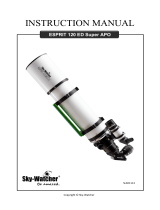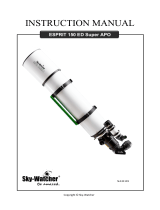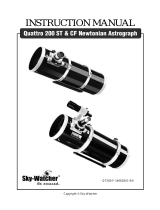Page is loading ...

1
INSTRUCTION MANUAL
ESPRIT 80 ED Super APO
Copyright © Sky-Watcher
SL140613

1
Table of contents
Table of Contents
Introduction ........................................................................................................................................ 2
Getting started ................................................................................................................................... 3
Parts description .................................................................................................................................. 3
Unpacking the telescope ...................................................................................................................... 3
Preparing the telescope for an observation .......................................................................................... 4
Cooling the telescope .......................................................................................................................... 4
Aligning the finder scope .................................................................................................................... 5
Using the telescope for visual observation ............................................................................ 6
Inserting the eyepiece .......................................................................................................................... 6
Focusing .............................................................................................................................................. 6
Using the telescope for prime focus imaging ....................................................................... 7
Installing the field flattener and a DSLR (Digital Single-Lens Reflex) camera .................................. 7
Installing the field flattener and a CCD (Charge-Coupled Device) camera ........................................ 8
Installing the field flattener and a CCD camera - continued ............................................................... 9
Focusing .............................................................................................................................................. 9
Framing the picture ............................................................................................................................. 9
Useful tips for all observations ................................................................................................ 10
Removing the finder scope ................................................................................................................ 10
Using the indexed scale ..................................................................................................................... 10
Rotating the focuser........................................................................................................................... 10
Specifications .................................................................................................................................. 11
Telescope specifications .................................................................................................................... 11
Threads specifications ....................................................................................................................... 11

2
Introduction
The spirit of perfection, by Sky-Watcher
Designed with the discerning astronomer in mind, Sky-Watcher top-of-the-line Esprit refractors
deliver the kind of imaging performance one would expect from telescopes costing much more. With
their three-element air spaced objective lens design, false color is completely eliminated, yielding
exceptional contrast and sharpness.
The 2.7" CNC machined 1:11 rotatable dual speed linear power focuser provides a smooth, rock-solid
focusing with zero image shifts. The Esprit ED 80mm refractor comes with a 9 x 50 right angle finder
scope, 2-inch Star diagonal, EQ5 (Vixen-style) dovetail, eyepiece and padded case. Everything you
need to get out under the stars.
The 2-element thread-on 48mm field flattener guarantees excellent field flatness across the entire 33
mm imaging plane. Its oversized lenses ensure a larger and clearer aperture and also extremely
minimized halation.
Quick overview:
• 80 mm apochromatic, 3-element refractor
• 400 mm (f/5)
• Metallic high-transmission lens coatings
• 2.7" CNC machined 1:11 dual-speed focuser
• Zero color fringing even on bright objects
• 33 mm image circle
• Knife-edge Baffled Optical System
• 2" Diagonal with dielectric coatings
• 9x50 erect-image 90° finder scope
• EQ5 dovetail (Vixen style) bar
• Aluminum foam lined case
• Thread-on field flattener
• APS-C corrected focal plane
NEVER USE YOUR TELESCOPE TO LOOK DIRECTLY AT
THE SUN. PERMANENT EYE DAMAGE WILL RESULT.
NEVER USE AN EYEPIECE-TYPE SOLAR FILTER.
NEVER USE YOUR TELESCOPE TO PROJECT SUNLIGHT
ONTO ANOTHER SURFACE; THE INTERNAL HEAT BUILD-
UP WILL DAMAGE THE TELESCOPE OPTICAL ELEMENTS.
USE A PROPER SOLAR FILTER FIRMLY MOUNTED ON THE
FRONT OF THE TELESCOPE FOR VIEWING THE SUN.
WHEN OBSERVING THE SUN, PLACE A DUST CAP OVER
YOUR FINDERSCOPE OR REMOVE IT TO PROTECT YOU
FROM ACCIDENTAL EXPOSURE.
NEVER LET A TELESCOPE POINTING THE SUN
UNATTENDED.

3
Getting started
Parts description
1. Dew cap
2. EQ5 (Vixen) dovetail bar
3. 9x50 erect-image 90° finder scope
4. 2.7" 1:11 dual-speed focuser
5. 2" dielectric diagonal
6. 2" eyepiece f= 28mm
Unpacking the telescope
Your telescope is inside the sturdy aluminum padded case, designed to
securely carry the telescope and the tube rings.
The case contains and protects the telescope and its accessories. Once
open you will find:
1. The telescope with dew cap
and EQ5
(Vixen style) dovetail bar.
2. The 9x50 erect-
image finder scope with
tube rings and mount.
3. The 2" (50.8mm) diagonal.
4. The 2-element thread-on field flattener
(used for photography only), guarantees
excellent field flatness across
the entire
33mm imaging plane, allowing picturing the
sky with large sensors.
Note: A ring spacer of 11mm is attached to
the field flattener body. Its usage will be
discussed on page 7 and 8.
5. 2" eyepiece, f= 28mm.
6. Thread-on field flattener
adaptor, used to
install the field flattener
on the focuser's
drawtube.
Some parts may be optional,
depending on the dealer's country.
Please check with him if any doubt.

4
Preparing the telescope for an observation
A.
Upon delivery, and when not used, the
telescope and its accessories are inside the
aluminum padded case.
Unpack the
instrument…
B. The instrument is ready to be placed on
the mount, via the EQ5 (Vixen style)
dovetail bar
. Please refer to your mount
manual for proper and secure installation.
C. The 9x50 erect-image finder scope is a
small fixed magnification scope mounted
on the optical tube. When it is correctly
aligned with the telescope, objects can be
quickly located and brought into the field
of telescope (see also "Aligning the finder
scope" chapter, on next page)
To
install the finder scope on the telescope
insert the positive dovetail of the finder
scope support inside the negative dovetail
mounted on the focuser, as shown in
picture.
Cooling the telescope
Telescopes require time to cool down to outside air temperature. This may take longer if there is a big
difference between the temperature of the telescope and the outside air. This minimizes heat wave
distortion inside telescope tube (tube currents). Your telescope would require at least 15 minutes
cooling off to outside conditions. Tip: use this time for planning your session and mount accessories.

5
Aligning the finder scope
The 9x50 erect-image finder scope is a small fixed magnification scope mounted on the optical tube.
When it is correctly aligned with the telescope, objects can be quickly located and brought to the
center of the field.
The alignment should be done at first use and over time if the alignment is no more accurate.
Alignment is best done outdoors in day light when it's easier to locate objects
If it is necessary to refocus your finder scope, sight on an object that is
at least 500 meters (or yards) away. Loosen the locking ring by
unscrewing it back towards the bracket. The front lens holder can now
be turned in and out to focus. When focus is reached, lock it in position
with the locking ring
Choose a distant object that is at least 500 meters (or yards) away and
point the main telescope at the object. Adjust the telescope so that the
object is in the center of the view in your eyepiece.
If you are using the star diagonal the image will be left/right
inverted, like images in a mirror.
Having an erected image, the view you have in the finder
scope has the same orientation as the landscape.
Check the finder scope to see if the object, centered in the
main telescope view, is centered on the crosshairs.
If not
unscrew the three blocking rings on the rear ring, then adjust
the three small screws to center the finder scope.
Do not over tighten the screws
when aligning the finder
scope. When the finder scope is correctly oriented, screw the
three blocking rings in position.

6
Using the telescope for visual observation
Inserting the eyepiece
• Loosen the two thumbscrews (1)
on the end of the focuser tube.
• Insert the 2" diagonal (2) into the
focus tube and re-
tighten the
thumbscrews (1)
to hold the
diagonal in place.
• Loosen the diagonal's screw (3).
• For 2" eyepieces (4a)
, insert it
into the diagonal and secure it by
re-tightening the thumbscrew (3).
•
For 1.25" eyepieces first insert
the 2" to 1.25" adapter (4b) into
the diagonal and secure by re-
tightening the screw (3). Loosen
the adapter's screw (5) and insert
the 1.25" eyepiece (6) inside the
adapter ring, then secure it by re-
tightening the screw (5).
Focusing
• Make sure the locking lever below the focuser (1) is
unlocked (position as shown in picture).
• Slowly turn the focus knobs (2) one way or the other,
until the image in the eyepiece is nearly sharp.
• To finely focus the image turn the 1:11 knob one way or
the other until the image is perfectly sharp (3).
• Lock the screw below the focuser (1) if a heavy load is
attached (pull the lever at 90°).
The image usually has to be finely refocused over time, due
to small variations caused by temperature changes. This
often happens when the telescope has not yet reached
outside temperature.
Refocusing is almost always necessary when you change an
eyepiece.
When looking through a diagonal, the image
is inverted left to right, as an image in a
mirror. This is normal and has no incidence
for astronomical observations.
If you plan to do terrestrial observation often, like bird
watching, optional image-erecting devices such as the
Amici prism or the erected 90° diagonal may be the right
tool.
Your reseller will be glad to advise you about the best
optional part that can be used with your telescope.

7
Using the telescope for prime focus imaging
Before installing the field flattener
onto the drawtube of the
focuser, the 2" ring adaptor (2)
needs to be unscrewed and
removed.
In order to easily unscrew the ring, hold with one hand the ring (1)
at the end of the drawtube and then unscrew the 2" ring adaptor
(2) with the other hand.
The Sky-Watcher ESPRIT 80 Field flattener
has been specifically designed for your
telescope. It guarantees excellent field flatness across the entire 33
mm imaging plane
and ensures full illumination with extremely minimized halation and zero color fringing
even on bright objects.
No "universal" field flattener available on the market will deliver the premium results
achieved with the Sky-Watcher ESPRIT 80 Field flattener which is designed
exclusively for this telescope.
Installing the field flattener and a DSLR (Digital Single-Lens Reflex) camera
Note: Inside the box the 6mm ring spacer (3) is assembled with the field flattener body (2). When
assembled, the two parts may look as if there were only one piece. When taking pictures with a DSLR
camera it should stay assembled.
1. Screw the drawtube adaptor (1) at
the end of the focus tube.
2.
Screw the field flattener (2) onto the
drawtube adaptor (1).
3.
If not yet done, screw the extender
tube (3) onto the field flattener (2).
4.
Screw the enlarged 48mm T-Ring
(4) onto the extender tube (3).
The enlarged 48mm T-Ring
may not be included with
your telescope and should
match your DSLR camera's
manufacturer and model.
Please check with your
reseller to get the correct
48mm Enlarged T-Ring for
your DSLR camera.
5.
Install your DSLR camera on the
48mm enlarged T-Ring (4).

8
In order to get the premium results the field flattener for
ESPRIT 8
0 can deliver the distance between the last
lenses to the sensor should be exactly 66
mm. This
distance is called the field flattener "back focus".
The rings are designed to provide 66mm of back focus
with any DSLR camera. Modifications to this layout, i.e.
by adding a radial guider, will lead to blurry stars images
in the field edges.
Installing the field flattener and a CCD (Charge-Coupled Device) camera
Installing an astronomical CCD camera and its accessories (filter wheel, radial guider…) behind the
field flattener is not as straightforward as installing a DSLR camera. All DSLR cameras have the exact
same distance from the front side of the T-Ring adapter to the sensor, thus share the same extension
rings to ensure the 66mm back focus distance.
CCD cameras differ from one model to another, even in the same brand name, by the threads used and
the body-to-sensor distance. Accessories also have different possible threads and depths, thus the
combination of a CCD camera and its accessories can have any total length and any coupling thread.
A custom coupling ring is needed in order to assemble the CCD camera and its accessories (called the
"optical train") to the telescope's field flattener. The custom ring should be machined* to have:
1) A female M62x1 thread, to screw and secure the ring to the field flattener exit.
2) A thread compatible with the first component of the optical train.
3) A length to ensure that the distance from the back of the field flattener to the CCD sensor is
exactly 66mm.
Note: Inside the box the 11mm ring spacer is
assembled with the field flattener body. When
assembled, the two parts may look as if there were
only one piece. When taking pictures with a CCD
camera it can be useful to remove the 11mm spacer
ring to gain 11mm additional back focus distance
The 66mm distance is measured from the edge
marking the start of the male thread on the field
flattener, to the CCD sensor (See picture on the
left).
Most CCD cameras have also the distance from
their body thread to CCD sensor noted in the
manual, thus evaluating the length of the custom
ring you need can be precisely evaluated.
* Refer to your local dealer about custom ring supply.

9
Installing the field flattener and a CCD camera - continued
1.
Screw the drawtube adaptor (1) at the
end of the focus tube.
2.
Screw the field flattener (2) onto the
drawtube adaptor (1).
3.
Screw the custom ring (3) onto the
field flattener (2).
The custom ring needs to be
sturdy enough to secure the
optical train to the field
flattener.
4.
Screw your optical train to the custom
ring (3).
Focusing
• Make sure the locking lever below the focuser (1) is
unlocked (position as shown in picture).
• Slowly turn the focus knobs (2) one way or the other,
until the image in the eyepiece is nearly sharp.
• To finely focus the image turn the 1:11 knob one way or
the other until the image is perfectly sharp (3).
• Lock the screw below the focuser (1) if a heavy load is
attached (pull the lever at 90°).
The image usually has to be finely refocused over time, due
to small variations caused by temperature changes. This
often happens when the telescope has not yet reached
outside temperature.
Framing the picture
When the object you want to picture is in the middle of the circular 33mm field, most often its
orientation on the rectangular camera APS-C sensor is not what you expected (figure A). You can
easily reframe the picture on the camera sensor by unscrewing the blocking ring (1) at the end of the
focuser drawtube, then turning the adapter ring (2) with all the optical train until the framing suits your
needs (figure B). When done screw the ring (1) to lock position, and you are ready to picture the sky.

10
Useful tips for all observations
Removing the finder scope
During an observation, when the desired target is acquired, it
is possible to remove the finder scope from its support. When
needed the finder scope can be inserted again.
This can be useful when
the observer's head is in a position
where the finder scope becomes an obstacle to observation.
Using the indexed scale
The indexed scale on the focuser drawtube gives an accurate
indication on the focus position for various accessories.
Once the posi
tion for one accessory is known it is very easy to
approximate the focus position.
Due to the precision needed to reach perfect focus a fine
tuning is advised.
Rotating the focuser
The whole focuser body can be rotated. It is useful when the
focuser knobs aren't in a convenient position.
1. Remove all accessories from the focuser.
2. Fully retract the drawtube inside the focuser body.
3. Unscrew the "boat wheel" like large aluminum ring.
4. Rotate the focuser body.
5. Tight back the "boat wheel" like large aluminum ring.

11
Specifications
Telescope specifications
Optical Design
Refractor (air-spaced triplet APO)
Field Flattener
Thread-on (2 lenses)
Aperture (mm)
80 mm (3.15 in)
Focal Length
400 mm (15.75 in)
Focal Ratio
5
Finderscope
9x50, erect-image, right-angle
Diagonal
2" dielectric coatings
Dovetail
EQ5(Vixen style) dovetail plate
Highest Useful Magnification
180 x
Lowest Useful Magnification
11 x
Limiting Stellar Magnitude
11.6
Resolution (Rayleigh)
1.74 arc seconds
Resolution (Dawes)
1.45 arc seconds
Light Gathering Power (Compared to Human Eye)
131 x
Optical Coatings
Fully multi-coated
Fully Illuminated Field With Field Flattener
33 mm (1.3 in)
Optical Tube Length
44.6 cm (17.6 in)
Optical Tube Weight
4.05 kg (9 lbs)
Telescope Visual Backfocus
∗
> 160mm (6.3 in)
Field Flattener Backfocus**
66mm (2.4 in)
Threads specifications
Rings/
Threads
Focuser
Tube
Drawtube
Adaptor
Field
Flattener
DSLR
Ext. Tube
Enlarged
T-Ring
In Ø
n/a
M74x1 F.
M65x1 F.
M66x1 F.
M48x0.75 F.
In screw depth
n/a
7 mm
8 mm
6 mm
variable
Out Ø
M74 x1 M
M65x1 M.
M66x1 M.
M48x0.75 M
Camera
Out screw depth
6 mm
6 mm
5 mm
5.9 mm
n/a
∗ The visual back focus of the telescope is the distance from the end of the focuser tube (with 2’’ adapter
installed) to the focal plane. This means, all accessories needing 160mm back focus or less can be installed.
** The back focus of the field flattener is the distance from the back of the field flattener to the focal plane.

12
We want to ensure that your experience with a Sky-Watcher
product is the best it can be. To make that happen we have a
comprehensive technical and customer support available,
alongside with the list of distributors and dealers worldwide, on
our worldwide internet site:
http://www.skywatcher.com
Sky-Watcher offers this product with the best available quality in
accordance with the legislation of the local market, and reserves the
right to modify or discontinue, without prior notice to you, any model
or style telescope.
/








